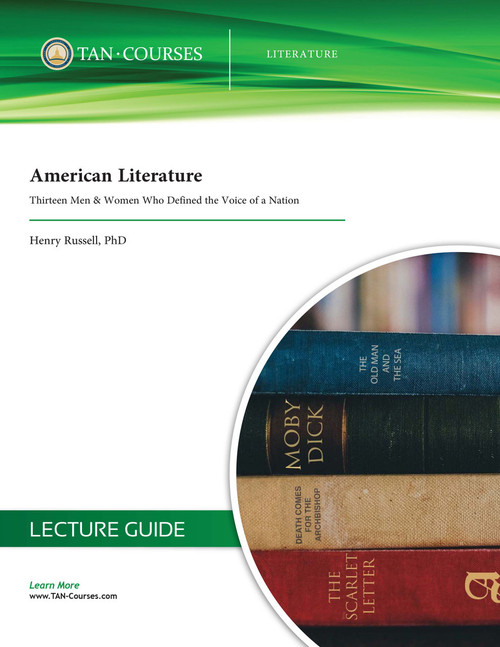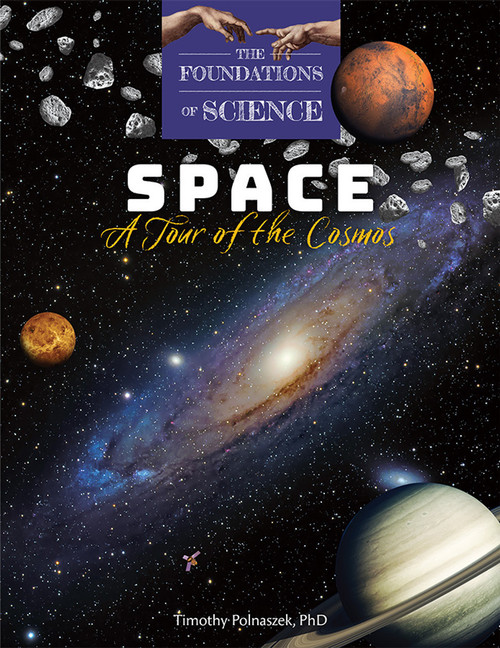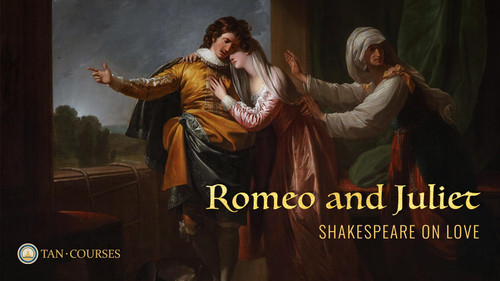TRAILER
LECTURE SAMPLE
The Voice of a Nation
Dr. Henry Russell, headmaster of St. Augustine Homeschool Enrichment Program and author of The Catholic Shakespeare Audio Series, joins TAN Courses in presenting American Literature: Thirteen Men & Women Who Defined the Voice of a Nation.
As Dr. Russell unfolds: although seldom acknowledged, Catholicism profoundly influenced the development of our country in ways that often go unseen and, sadly, untaught in classrooms. You may have read many of the works discussed in these lectures. However, most schools in our country undoubtedly rob our youth through the lack of acknowledgment that the Catholic Church played a pivotal role in many of the greatest American writers and their works, either directly or indirectly. While not all of these great American writers have been Catholic, Dr. Russell shows how Catholicism influenced many of their works through American culture and the influence of their preceding American writers.
This course will examine how Catholicism influenced America through the lens of American literature. This course helps us all understand the nation we live in today and where we might be going. As always, we look to the past to help us understand where we may go in the future. How did American literature form what we now recognize as American culture? What ideals were instilled in Americans, particularly in the subtle philosophy integrated into these authors' works? What does this tell us about the direction in which our country is still heading?
Understanding Literature Like a Scholar
Dr. Russell trains students in the art of rigorous conversation with these literary texts. This course covers many different works recognized as classics in American literature while analyzing key themes such as:
- The effects of religious persecution in America
- The roots of America's spirit of freedom
- Man versus nature: human dignity and the presence of God in His creation
- The long-lasting consequences following the horrors of slavery
- The beauty and the dangers of romantic moralism
These 32 lectures are both profoundly Catholic and highly intellectual but eminently accessible to high school students. This course coincides with the TAN Academy high school Literature curriculum and book list. You do not want to miss this deeply Catholic journey into American literature!
LECTURES
- Ralph Waldo Emerson
What is a true "romantic" in literature? Certain truths and beliefs held by the romantics are recognized as somewhat unconventional. Discuss this kind of "romantic moralism" and consider the dangers of this kind of thinking and how it might affect literature and morality. - The Scarlet Letter Part 1
Nathaniel Hawthorne's The Scarlet Letter is a kind of powerful rejection of emersonianism. Discuss romanticism's legitimate role in The Scarlet Letter as Hawthorne sees and presents it through his discussions on topics such as sin, utopia, and shame. - The Scarlet Letter Part 2
The character of Pearl was "misshapen" by her mother and affected deeply by sin, yet has become what she will be before she is even born. Does Hawthorne's presentation of Pearl suggest that he believes children are developed minds and souls in the womb? Likewise, could this point to the importance of the nature and presence of fatherhood? - The Scarlet Letter Part 3
What is Chillingworth's proper role in this story? We look to the massive turning point for Hester Pryne, where she finally ponders whether Pearl is meant to be a punishment or, rather, a blessing. Could Pearl be providence's mercy and benefice to Hester? - The Scarlet Letter Part 4
Pearl is seen as a child with extreme care for the truth, even when that comes with difficulty and pain. Consider more themes of romanticism found in the conclusion of The Scarlet Letter. What does the disappointing end of the story tell us about Hester and about the true meaning of the story? - Moby Dick Part 1
Who was Herman Melville? While he began much of his writing about the topics of cannibalism and the vicious and cruel life a sailor has to endure, his works became continuously more philosophical as he continued his writing career. Compare the romanticism of Melville's work to that of Hawthorne. - Moby Dick Part 2
Dr. Henry Russell tells us that authors always try to tell us something. They are teachers, in some way. What themes is Melville driving at in Moby Dick? He seems to introduce a sense of spirituality in the story. Does Melville believe in the God of the Old Testament? - Moby Dick Part 3
Moby Dick is a book about the danger to society of romantic men who have divorced themselves from ordinary understandings of the good and real. It is a book about what is true and how to respond to what is true. Consider the multiple ways Melville presents his fascination with the necessity to discern the will of God. - Moby Dick Part 4
Continue discussing Ahab and his philosophical way of looking at life. Finally, learn more about his motivations for what Melville calls "the fiery hunt" for Moby Dick. - Moby Dick Part 5
The following chapters introduce us to the younger Melville, before the author’s embrace of philosophy and imbuement of his work with deeper meaning. Through this more raw form of Melville's writing, we get a better view of the extraordinary act of whaling in the mid-1800s. - Moby Dick Part 6
Join Dr. Russell exploring how Moby Dick becomes more allegorical and symbolic as they finally spot the white whale. View Ahab in a place of vulnerability, perhaps what could be considered a humbling moment. What do we learn about the character of Ahab in these moments? - Moby Dick Part 7
Ahab is granted a last chance to abandon the hunt for Moby Dick. Why might this be? Is this moment perhaps an expression of the fabulously beautiful goodness of God in His creation? Why would Melville point us to this at the end of his work? - Death Comes for the Archbishop Part 1
Who was Willa Cather? Study her young life and education that made her into the writer she became. Discover how Death Comes for the Archbishop, along with her numerous other works, shows her immense love and appreciation for the Catholic Church. - Death Comes for the Archbishop Part 2
Discuss the character of Fr. Gallegos, his particular embodied representation of the Catholic Church in the story, and the challenges this introduces. Contrast this character to the character of Fr. Jesus, who establishes how Cather wishes to present the Church. - Death Comes for the Archbishop Part 3
Padre Martinez thinks of himself as "the new Church" to meet modern needs by changing the Church with the times. Cather immediately recognizes this as heresy and calls it "the old order." Discuss how this sheds light on the sacredness of the Church that Cather clearly holds very dear. - Death Comes for the Archbishop Part 4
Consider the low fertility rates of the Indians and Americans post World War I. In these difficult times, and during controversial debates of politics and religion, the Catholic Church emphasizes its commitment to all of humanity rather than just a singular nation or people. - Uncle Tom's Cabin Part 1
Harriet Beecher Stowe wrote Uncle Tom's Cabin as an introduction to what the south came to call its "peculiar institution.” Intending to present the humanity of different groups of people caught up in a slave system, Stowe aimed to inspire "unimportant people" to somehow act decisively within their own small spheres of influence. - Uncle Tom's Cabin Part 2
Stowe states, "Perhaps the mildest form of the system of slavery is to be seen in the state of Kentucky." Here, she introduces the readers to her characters. Which characteristics does Stowe appear to find most important in a moral person? In Stowe's opinion, can a slave trader be seen as a good person? - Uncle Tom's Cabin Part 3
Discuss the character of Haley, a crude, utilitarian, inhuman slave trader who forces Tom, Eliza, and little Harry away from the Shelbys. He prides himself on being kind, yet Stowe tells us this is not true at all. Consider the vice of false humility and how toxic it is to the soul; is Haley an example of this? - Uncle Tom's Cabin Part 4
The first of the Christian heroes in this book is Uncle Tom himself. The only other character who rises to his dignity is young Eva, and another who is close is George Harris. Consider why Stowe finds it essential to recognize these characters as the heroes of the story and what this teaches us about her recognition of virtuous dignity. - The Adventures of Huckleberry Finn Part 1
Consider the biography of Mark Twain, particularly in light of Chapters 1-6 of his work The Adventures of Huckleberry Finn. Dr. Russell tells us this work can easily be tied to Stowe's Uncle Tom's Cabin. While these are different kinds of books, and the authors are also distinctly different, what elements between these works are held in common? - The Adventures of Huckleberry Finn Part 2
Dr. Russell suggests that this book is full of "the typical darkness of Twain." When Huck and Jim find each other, Huck claims he is having some crisis of conscience in regards to not turning him in. Knowing the character of Huck, this is difficult to believe; what does this reveal about Huck's self-interested character to us? - The Adventures of Huckleberry Finn Part 3
Just as the story takes an unexpected turn to romanticism, Huck and Jim meet two con-men. Here, Huck encounters two dishonest men preying on his immaturity and sympathy. What lessons about honesty and trust does Huck learn? - The Adventures of Huckleberry Finn Part 4
The young and older men will begin down the river and enter into an almost farcical holiday world of the imagination - and yet a dangerous world that could get somebody killed. Reconsider Huck's maturity and contemplate how he has changed throughout the story. - American Modern Poets Part 1: E.A. Robinson
Why are the American poets and their world important? What is American modern poetry? Study Edwin Arlington Robinson. Who was he? What were his works? Discover what Americans most loved about his works. - American Modern Poets Part 2: Robert Frost
Robert Frost is widely regarded as a great, even massive, poet. He stands as a vast figure dominating American poetry. In this lecture, Dr. Russell discusses one key element that plays into Frost’s appeal to the American audience. - American Modern Poets Part 3: T.S. Eliot & Ezra Pound
Many poets, especially those who went abroad, were, as they claimed, "searching for a new language" for poetry. However, unlike Frost, T.S. Eliot and Ezra Pound were not content to make the old language more extraordinary by simply bringing it forward into their own age. Discuss the approaches these two poets lead with and how they differ from Frost's. - Modernism's Orthodoxies and Ernest Hemingway Part 1
By now, we have seen the sense of desperation, isolation, and intermittent Godlessness in Robinson, Frost, Pound, and Eliot. Why did each of these figures, among others, find themselves in such doubt? Why will we find Hemingway in the same place? - Modernism's Orthodoxies and Ernest Hemingway Part 2
As one reads Hemingway, they begin to wonder, if not a Christian, was he haunted by Christ in his writings? He was nominally Catholic, but did he live that, and can traces of his religion be found in his writing? - The Southern Renaissance Part 1: William Faulkner
What was the southern renaissance? The greatest of poets in fiction was often acclaimed to be William Faulkner. However, his lifelong theme in his writing always centered around slavery. To what pivotal parts of the southern renaissance does this point? - The Southern Renaissance Part 2: William Faulkner
Study perhaps Faulkner's most famous writing, The Bear, which features the same characters from Old People. The bear is known to man as invulnerable, yet he lives in a shrinking wilderness for which he is too big now. Dive deeper into The Bear and discover the profound meaning within the text. - The Southern Renaissance Part 3: Flannery O'Connor
Who was Flannery O'Connor? She took very seriously the importance of representing the Church well, and much of her work reflects her religious beliefs. Dr. Russell illuminates how her unwavering fidelity to the Catholic Church is present throughout all of her work.
- Author:
- Henry Russell, PhD
- Publication Date:
- 09/13/22
- Product Format:
- Streaming Video
- Imprint:
- TAN Courses














